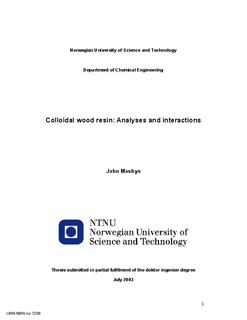| dc.contributor.author | Mosbye, John Erlend | nb_NO |
| dc.date.accessioned | 2014-12-19T13:10:46Z | |
| dc.date.available | 2014-12-19T13:10:46Z | |
| dc.date.created | 2003-09-01 | nb_NO |
| dc.date.issued | 2003 | nb_NO |
| dc.identifier | 124922 | nb_NO |
| dc.identifier.isbn | 82-471-5615-6 | nb_NO |
| dc.identifier.uri | http://hdl.handle.net/11250/244476 | |
| dc.description.abstract | This thesis presents studies of the interactions between suspended particles and dissolved and colloidal substances (DCS) in process water. The main focus has been to determine if colloidal wood resin is adsorbed by suspended fines or fillers, and how the dissolved material influences this adsorption. The effect of some synthetic polymers on this adsorption has also been investigated.
Successive refining of mainly Norway spruce followed Successive refining of mainly Norway spruce followed by removal of the produced fines after each refining stage, resulted in fines with different physical and chemical properties. In the first refining stage mainly flake-like fines were produced, while more fibrillar fines were produced in later refining stages. The different types of fines were analysed for both the bulk and the surface composition. Variation in the chemical composition between the fines was particularly striking with regard to the surface composition. Special attention was also given to the amount and origin of charged groups since these may consume cationic additives in the papermaking process. After alkali treatment, between 80 and 90% of all the charged groups measured by polymer adsorption originated from three uronic acids.
Fines were shown to adsorb model colloidal wood resin, but the adsorption was greatly influenced by the pH or salt content. Also the amount of dissolved components in the suspension, which sterically stabilised the colloidal wood resin, was shown to strongly influence the adsorption of the colloidal wood resin to the fines. The flake-like fines adsorbed the colloidal wood resin to a higher extent than the fibrillar fines. This selectivity was also possible to obtain by using polyethyleneoxide (PEO). PEO removed the sterically stabilised colloidal wood resin more efficiently when flake-like fines rather than fibrillar fines were present. For comparison, cationic polyacrylamide (CPAM) did not have this selectivity. The selectivity of PEO was explained by a higher affinity to flake-like fines than fibrillar fines. It was shown that more PEO adsorbed to flake-like fines rather than to fibrillar ones. PEO may adsorb to extractive surfaces, but was inhibited by adsorbed components from the dissolved fraction. The degree of stabilisation was also shown to influence the adsorption of the colloidal wood resin by other particles like fillers. This adsorption, which was energetically favourable, did not occur at high concentrations of dissolved material. | nb_NO |
| dc.language | eng | nb_NO |
| dc.publisher | Fakultet for naturvitenskap og teknologi | nb_NO |
| dc.relation.ispartofseries | Dr. ingeniøravhandling, 0809-103X; 2003:63 | nb_NO |
| dc.relation.haspart | Mosbye, J; Harstad, B; Fiksdahl, A. Solid phase extraction (SPE) of hydrophobic components from a model white water. Nordic Pulp Paper Res. J.. 15(2): 101, 2000. | nb_NO |
| dc.relation.haspart | Mosbye, J; Moe, S; Laine, J. The charge and chemical composition of fines in mechanical pulp. Nordic Pulp Paper Res. J. 17(3): 352, 2002. | nb_NO |
| dc.relation.haspart | Moe, ST; Mosbye, J. Swelling of mechanical pulp fines after chemical treatment. 12th Int. Symp. Wood Pulping Chem, 2003. | nb_NO |
| dc.relation.haspart | Mosbye, J; Laine, J; Moe, S. The effect of dissolved substances on the absorption of colloidal extractives to fines in mechanical pulp. Nordic Pulp Paper Res. J. 18(1): 63, 2003. | nb_NO |
| dc.relation.haspart | Mosbye, J; Moe, S; Tammelin, T; Saarinen, T; Laine, J. The ability of PEO to remove model colloidal extractives from solutions with different types of fines. Nordic Pulp Paper Res. J., 2003. | nb_NO |
| dc.relation.haspart | Mosbye, J; Foss, MH; Laine, J; Moe, S. Interaction between model colloidal wood resin, fillers and dissolved substances. Nordic Pulp Paper Res. J. 18(2): 194, 2003. | nb_NO |
| dc.subject | Chemical engineering | en_GB |
| dc.subject | TECHNOLOGY: Chemical engineering | en_GB |
| dc.title | Colloidal Wood Resin: Analyses and Interactions | nb_NO |
| dc.type | Doctoral thesis | nb_NO |
| dc.contributor.department | Norges teknisk-naturvitenskapelige universitet, Fakultet for naturvitenskap og teknologi | nb_NO |
| dc.description.degree | dr.ing. | nb_NO |
| dc.description.degree | dr.ing. | en_GB |
